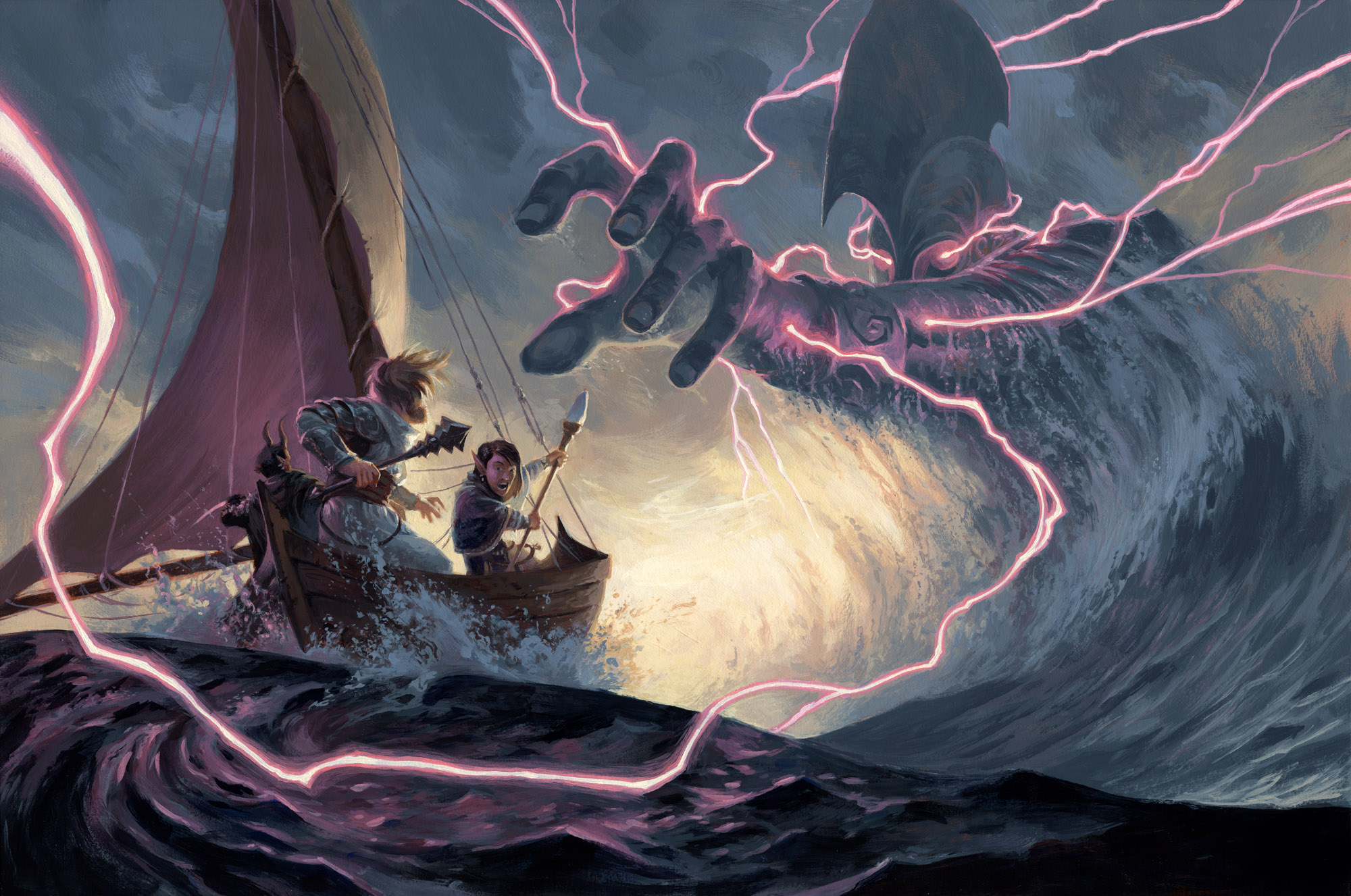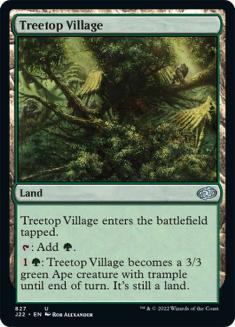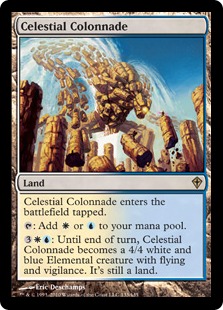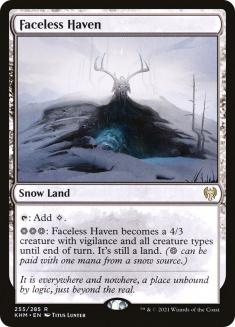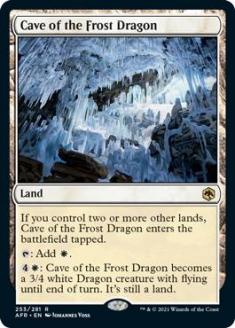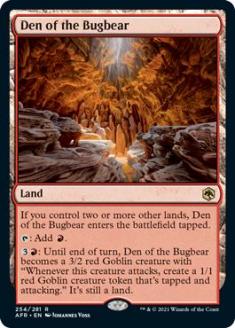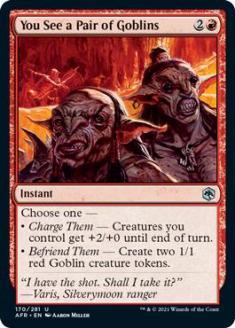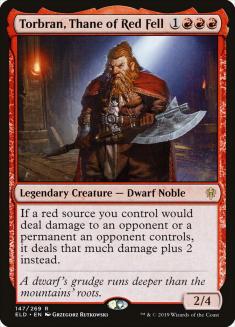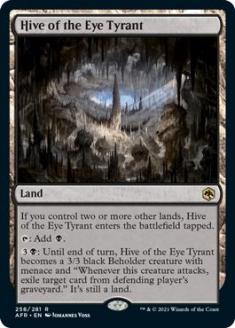Creature-lands are one of the most proven cycles in the history of Magic. From the original Mishra’s Factory to Treetop Village, Celestial Colonnade, Mutavault, and eventually Faceless Haven, most creature-land cycles have had at least some members see play. I believe that the new cycle of “creature-fastlands” will also find success.
The condition in all of these lands is the same — if you have two or more other lands, they enter the battlefield tapped. This is a step behind the original fastlands (they can be your third land and enter untapped whereas these cannot), but it’s definitely a step ahead of the original enters-the-battlefield-tapped creature-lands. As a general rule, I’d say that the first two turns are the most critical anyway; you can have these in your opening hand and they also accommodate another land that enters the battlefield tapped and can team together to play a two-drop.
If you draw multiples of those alongside other tapped lands you’re going to run into trouble, but these lands will enter the battlefield untapped when it matters most (early in the game), which means they facilitate playing one- and two-drops. They’ll enter the battlefield untapped if they’re among the first eight or nine cards you see, which is pretty good.
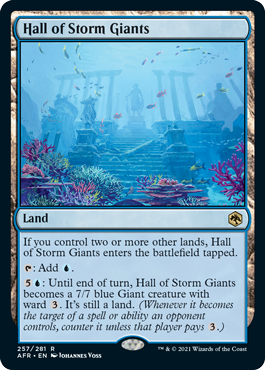
Hall of Storm Giants is far and away the biggest creature-land we’ve ever seen (outside of Svogthos, the Restless Tomb, I guess). A 7/7 creature is just enormous — almost twice the size of the previous biggest creature-lands that saw the most play (Celestial Colonnade and Faceless Haven). It matches up well against Lovestruck Beast, Elder Gargaroth, and even Polukranos, Unchained or Vorinclex, Monstrous Raider. And, most importantly, it kills them really quickly! In a straight control deck you might not care if it takes three or six turns to kill them, but there are several decks eligible to play Hall of Storm Giants that can deal thirteen damage and then threaten to end everything in one attack.
You might think ward 3 is not that relevant at the point in the game where Hall of Storm Giants would be activated, but I believe this ability is deceivingly powerful on a creature-land. If you cast your seven-drop and they need to pay five to Heartless Act it, that’s fine — it’s a price they’re willing to pay and they know it’s coming. With Hall of Storm Giants, though, you set the terms for when it’s going to be a creature, so they can’t just spend five mana to Heartless Act it at their leisure.
Imagine, for example, that you have a card you want to cast and a Heartless Act. Your opponent is threatening to activate Hall of Storm Giants and attack for seven, so you decide to hold Heartless Act for it, but that’s not cheap to do (it likely uses up your entire turn). Then they untap and… don’t activate Hall of Storm Giants. They get to continue playing their game normally, but the threat of a 7/7 with ward 3 made you skip your whole turn and you might continue to do so until they decide it’s time to activate it. Because of ward 3 specifically and the fact that the owner of Hall of Storm Giants gets to choose when the interactions happen, I think this is quite a bit better than it looks.
So where would I play Hall of Storm Giants? Honestly, I think it might see play in any blue deck. You’re almost never going to play four of it since it does cost six to activate (effectively seven, since you need the creature to be untapped), but I can see situations in which having access to the Giant is going to be better than having Sea Gate Restoration in a Sultai Ramp (Yorion) deck, for example.
One deck that I think might make good use of it is Dimir Rogues. Dimir Rogues is very color-intensive early on, so it appreciates the untapped land, and it sometimes plays this aggro-control “kill you out of nowhere” game where having access to a 7/7 really shines. I’m not sure it’s actually better than Agadeem’s Awakening, but I would start with two copies:
Creatures (16)
Lands (18)
Spells (24)

Another possible option is Izzet Dragons❄, and here we arrive at the biggest possible conundrum for these creature-lands — the clash with Faceless Haven. They clash in two different ways: first because there’s a limit to how much mana you can spend on creature-lands, and second because they’re not snow lands for Faceless Haven itself (and to an extent for Frost Bite). However, I don’t think there’s much stopping you from playing at least a couple of copies of Hall of Storm Giants in addition to Faceless Havens in Izzet Dragons❄.
In general, this deck uses creature-lands differently from builds like Mono-Red Aggro❄. It’s not trying to attack for four on Turn 4 or after a sweeper; it’s trying to use it as a combo to finish them off once you gain extra turns with Alrund’s Epiphany, where having a 7/7 for seven is likely better than having a 4/3 for three. Besides, this is a very color-intensive deck (Goldspan Dragon costs RR, Brazen Borrower sometimes costs UUU), so having a colorless land is a huge cost, and the fact that Hall of Storm Giants produces blue mana can be very relevant.
Here’s how I would build the deck, with two copies of Hall of Storm Giants:
Creatures (15)
Lands (23)
Spells (20)

RIght now, we don’t have a Mono-Blue Tempo deck in Standard, but if we do at some point, it wouldn’t surprise me if it sported a couple of copies of Hall of Storm Giants.
Cave of the Frost Dragon reminds me of Celestial Colonnade, but having a three-power flyer is very different from having a four-power flyer — one kills in five turns, the other in seven. Colonnade also taps for two different colors of mana and has vigilance, both of which are very relevant. In return, Cave of the Frost Dragon is a land that might enter the battlefield untapped and also only requires one color of mana. All in all, I’d say Colonnade is definitely the better card.
However, the comparison only goes so far; after all, Celestial Colonnade is a very good card and it’s not legal in Standard. There’s a lot of room for a card to be worse than Celestial Colonnade and still be good, especially since it only requires half as many colors to enable. So, is Cave of the Frost Dragon good?
To me, no — at least not until Faceless Haven rotates. In a deck like Izzet Dragons❄, I believe Faceless Haven and the new creature-lands can coexist because the goal of the deck is not to be attacking on Turn 4, so the speed bump of having a non-Snow land is not a disaster. In Mono-White Aggro❄, which is the premier aggro deck in Standard right now, you really want to be able to curve out and then attack with Faceless Haven on Turn 4 on a lot of your games, so having your third land enter the battlefield tapped and/or not enabling Faceless Haven is simply too big a cost. The deck isn’t playing Castle Ardenvale or Emeria’s Call, so I’m skeptical it should play Cave of the Frost Dragon.
That said, there are white decks that are not mono-white, and therefore don’t have the Faceless Haven clash (for example, Naya Adventures or Boros Winota). It’s possible Cave of the Frost Dragon would be good in these decks, but I think the red creature-fastland is going to be better most of the time.
Den of the Bugbear is also a historical first in that it produces not only one extra attacker but two. In decks that particularly care about extra bodies (such as Naya Winota with Toski, Bearer of Secrets or Boros Winota with Winota, Joiner of Forces), this can be highly relevant (though the Goblin won’t trigger Winota on the turn it’s created). At four mana to activate, it’s also a lot cheaper than Den of the Frost Dragon, and it even attacks for one more damage if they don’t have blockers.
Here’s a sample Boros Winota list:
Creatures (31)
- 4 Bonecrusher Giant
- 4 Winota, Joiner of Forces
- 4 Selfless Savior
- 4 Luminarch Aspirant
- 3 Reidane, God of the Worthy
- 4 Professor of Symbology
- 4 Elite Spellbinder
- 4 Blade Historian
Lands (15)
Spells (14)

On top of Den of the Bugbear, the deck also finally gets an on-color way to produce two creatures in You See a Pair of Goblins. The power level of the card is a bit low, but curving that into Winota can be very powerful, so I’m definitely going to try it out (plus sometimes it will kill them out of nowhere).
The card also has potential in Mono-Red Aggro❄, where it again clashes with Faceless Haven. However, I think that, unlike the white version, it’s strong enough to compete. Faceless Haven is still better, and I think you should still play four of those, but it would not surprise me if Den of the Bugbear was stronger than Castle Embereth. This deck really likes creature-lands and the synergy with Torbran, Thane of Red Fell is very good — if you have Torbran out, the Den attacks for eight!
I would build my Mono-Red Aggro❄ deck like this:
Creatures (28)
- 4 Robber of the Rich
- 4 Fervent Champion
- 4 Bonecrusher Giant
- 3 Torbran, Thane of Red Fell
- 4 Rimrock Knight
- 4 Anax, Hardened in the Forge
- 1 Phoenix of Ash
- 4 Hall Monitor
Lands (24)
Spells (8)
Sideboard

Another important thing about Den of the Burbear is that, even though it’s the Den of the Bugbear, it’s actually a Goblin that makes Goblin tokens. Having your land become two creatures of your tribe for tribal payoffs is insane, and if we have a Goblins deck in Standard, Den of the Bugbear is almost certain to be a part of it. Right now this deck doesn’t exist, but Battle Cry Goblin is at least hinting at it, and surely a D&D-themed set will have more Goblins. In the meantime, I think there’s a reasonable chance this land sees play in Historic Goblins, as it can kickstart your Krenko, Mob Boss or attack for six with a Goblin Chieftain out.
Hive of the Eye Tyrant is another interesting one. It’s on the “cheap” end (at least for this cycle) in that it requires five lands to be able to attack, and a 3/3 menace creature is reasonable. The exiling-a-card ability is the kind of thing that you don’t really want to pay to have access to, yet can be randomly very relevant because when it matters it’s really going to matter, but in Standard that’s simply not going to be often enough to justify it.
My inclination is that Hive of the Eye Tyrant is not good enough right now either, as there’s just no place for it. If there is an aggressive black deck it will almost certainly prefer Faceless Haven, but I think any deck that’s both blue and black prefers Hall of Storm Giants, and any deck that is black and red will prefer Den of the Bugbear unless it’s really interested in the black mana early on, as getting an extra 1/1 is just more important than exiling a card most of the time.
Overall, I look forward to playing with the blue and the red versions of the cycle, and I think they will be quite good in Standard at least. If anything, building manabases will become a more interesting puzzle than it is now, as they potentially compete with other lands in several decks. The white and black versions are a bit disappointing and I don’t expect them to see much play. The green version is a question mark (it hasn’t been released yet as of the time of this article).
Though let’s be realistic. It’ll probably be good because it’s green.

